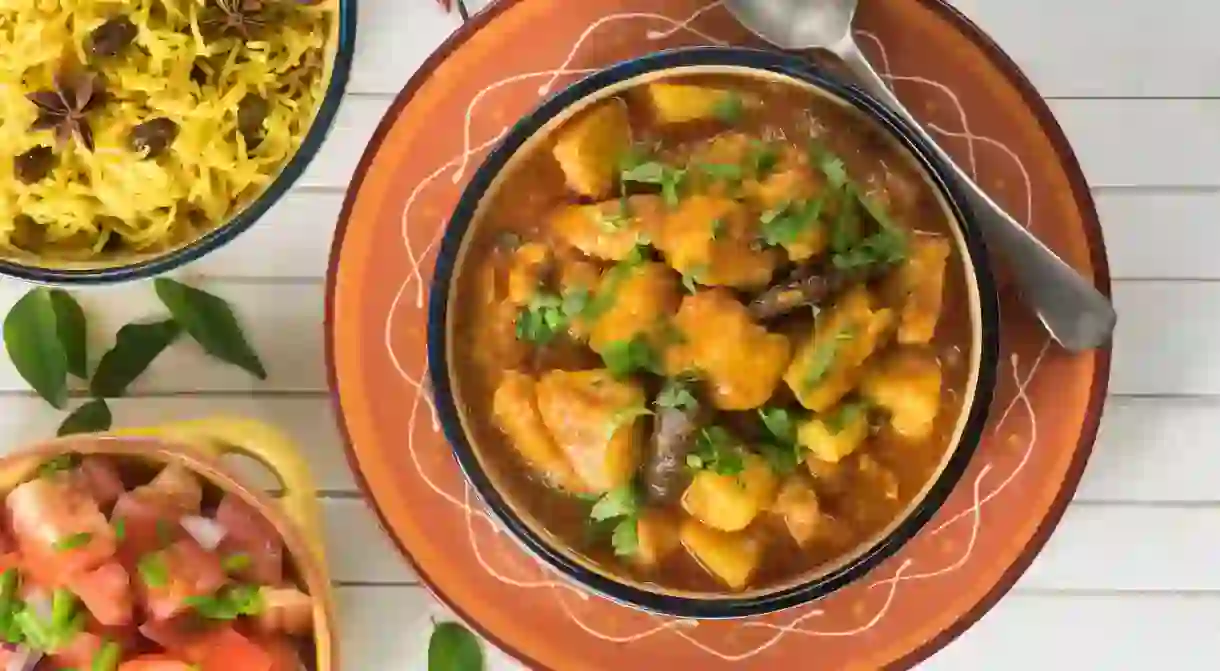Cape Malay Cuisine: South Africa’s Unique Southeast Asian Food Culture

Cape Malay food is a cuisine unique to the Western Cape of South Africa. It’s a style of food steeped in history and preserved through ongoing tradition. Most know the cuisine for its fruity, mild spices and full-bodied flavours, which are heavily influenced by its overseas origins.
The Cape Malay special style of cooking fuses traditions from Malaysian, Indonesian and East African slaves, who were brought to Cape Town by Dutch settlers in the 17th and 18th centuries. Today, Cape Malay cuisine remains an important part of the Western Cape’s culture and heritage, especially among the Muslim population of Cape Town.
According to Gadija Khan, who runs KaapseKos, a traditional Cape Malay catering company, this style of food has survived several generations as a key competent of Cape Malay culture, and its food’s presence at events has enabled it to remain particularly relevant.
“Everything revolves around food when it comes to Cape Malay functions,” says Khan. “We always have big, big meals, and there are always lots of people around the table and lots of different dishes – it’s always a colourful and flavourful thing.”
Piquant stews such as tomato bredie (stew), breyani and bobotie are firm favourites, as are roasts, spicy curries and sosaties (lamb or mutton kebabs). “We have a lot of stews that are served in traditional restaurants and at functions,” says Khan. “And for functions like Eid, or funerals and weddings, we’ll make specific dishes. During the month of Ramadan, when we fast from sunrise to sunset, we take a plate to neighbours to make sure that everyone in the neighbourhood has something to eat as well.”
Biryani (mixed rice) is a popular dish at large functions – it can feed a lot of people and will spread easier for a bigger group, Khan explains.
The flavour present in most Cape Malay dishes, Khan says, is largely due to the spices and their blends that have been handed down over generations. These give food a unique taste and an edge. “We often use masala, which is a combination of spices,” says Khan. “But the specific powdered spices that we’ll put in almost every dish are turmeric, cumin and coriander. We’ll add a masala to that, and then cloves, cardamon and cinnamon. These are the common things that go into most of the food to give it its flavour.”
Dried fruit, such as raisins and apricots, are also common additions, and these create the sweet-and-sour flavours that perfectly contrast with the included spices.
Most of the recipes contain some form of meat, usually fish (given the city’s coastal location), and vegetables. And if there are no vegetables in the dish, they’ll usually be served as a side.
Bread is also a key part of Cape Malay cuisine, and Khan says rotis (pronounced “rooties”) are particularly important. “Rice is a staple as a side dish for the stews,” she says. “But the roti is the one you’ll find with curries. You lap it up, and you have to use your hands – otherwise, it’s not going to taste the same!”
Khan, a seasoned cook herself, explains that there’s an art to making a true Cape Malay roti. “You get different types of rotis,” she says. “Whereas an Indian roti is basically made with hot water, our roti in the Cape is made with butter, flour and water. It’s layered, and butter gets spread on each, and it’s allowed to rest. So, the Cape Malay roti is much more layered compared to the Indian one, for example, which is softer.”
Sambals, a relish likened to salsa, are served with some dishes to spice them up, and these consist of grated vegetables or fruit seasoned with sugar, salt, chillies and vinegar.
Dessert also plays an important part in Cape Malay culinary traditions. There are several new additions to Cape Malay desserts, explains Khan, but there are two that go back right to the beginnings of the cuisine: the koesister and boeber.
Koesisters are essentially deep-fried dumpling-type desserts with spices and a cake-like texture, along with a dusting of coconut.
Boeber is a traditional sweet milk drink made with vermicelli, sago and sugar, and flavoured with cardamom, cinnamon and rose water. It’s a drink traditionally served during Ramadan, but also available at other times of the year. Another popular and delicious Cape Malay drink is falooda; it’s a sweet rose-flavoured milkshake topped with ice cream and softened basil seeds.
Cape Malay cuisine has influenced various other foods throughout the country. Its spices, flavours and specific dishes have crossed over into the mainstream in South Africa and abroad.
Bobotie, a fragrant, mildly spiced curry made with a rich and savoury custard and yellow rice, is a popular fixture on restaurant menus throughout the country. It also features on international cooking sites such as BBC Good Food and Epicurious, which called it “a hot contender for South Africa’s national dish”.
But with its varied roots and traditional recipes that are passed down from generation to generation, the cuisine’s combination of flavours that result in hearty, aromatic dishes are still best enjoyed around family dinner tables in Cape Town, at homes like Khan’s.
“Cape Malay cuisine is about more than the food,” says Khan. “Food brings you together, no matter where you are!”
Where to find Cape Malay cuisine
Although dishes have made their way on to menus throughout the city, the focal point for Cape Malay food in Cape Town is still in the neighbourhood of Bo-Kaap. And even there, traditional restaurant options are growing increasingly limited. Some cafés and kitchens serve snacks and other local delicacies, but Khan says one of the best options for traditional Cape Malay cuisine is Bo-Kaap Kombuis, on Upper Wale Street. Meanwhile, Upper Bloem Restaurant, in the suburb of Green Point, offers a more fine-dining take on Cape cuisine.
This is an updated version of a story created by Lee-Shay Collison.













